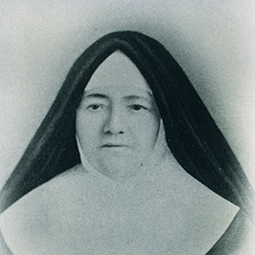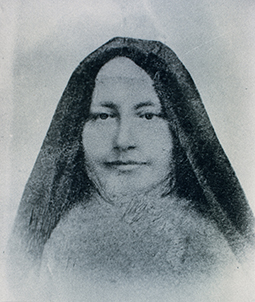Several communities of religious sisters are highlighted in a new exhibit at the Missouri History Museum that examines the contributions of women in St. Louis leading up to the suffrage movement in the early 20th century.
“Beyond the Ballot: St. Louis and Suffrage” opened in August in honor of the 100th anniversary of the passage of the 19th amendment, giving women the right to vote. The two-part exhibit also provides specific details of the efforts by St. Louis women in the fight for women’s suffrage.
Featured are the Sisters of St. Joseph of Carondelet, The Society of the Sacred Heart, the Sisters of St. Mary (now known as the Franciscan Sisters of Mary) and the Sisters of Charity (now known as the Daughters of Charity). Other Catholic laywomen, including Francoise LeDuc and Anne Lucas Hunt, also are noted for their contributions.
“We wanted to show the complexities, but also celebrate that they were these strong women,” said Missouri History Museum curator Katie Moon. These religious communities were often small groups who came from abroad and had very few resources as they established ministries in areas including health care, education and social work, she said.
Four Daughters of Charity came from Maryland in 1828 at the request of Bishop Joseph Rosati to open the first hospital west of the Mississippi River and the first Catholic hospital in the nation. They cared for the sick — including many affected by the cholera epidemic in 1849 — and operated several schools, an orphanage and a psychiatric hospital.
 Mother St. John Fournier was chosen by Mother St. John Fontbonne to serve at a mission in St. Louis teaching deaf children. She eventually moved to Philadelphia to work at an orphanage and established the Sisters of St. Joseph of Philadelphia.Photo Credits: COURTESY OF THE SISTERS OF ST. JOSEPH OF CARONDELET-ST. LOUIS PROVINCE COLLECTION, CARONDELET CONSOLIDATED ARCHIVE“St. Louis has been fortunate to have so many religious communities that were the foundations for many of the things that happened in the city,” including health, education and caring for orphaned children, said Sister Catherine Mary Norris, DC, the provincial of the Daughters of Charity Province of St. Louis. “This was at a time when women weren’t necessarily recognized for the contributions they made. I think about all of those women who were courageous when it wasn’t in vogue for them to get involved. The sisters were lucky they had a freedom that laypeople didn’t always have.”
Mother St. John Fournier was chosen by Mother St. John Fontbonne to serve at a mission in St. Louis teaching deaf children. She eventually moved to Philadelphia to work at an orphanage and established the Sisters of St. Joseph of Philadelphia.Photo Credits: COURTESY OF THE SISTERS OF ST. JOSEPH OF CARONDELET-ST. LOUIS PROVINCE COLLECTION, CARONDELET CONSOLIDATED ARCHIVE“St. Louis has been fortunate to have so many religious communities that were the foundations for many of the things that happened in the city,” including health, education and caring for orphaned children, said Sister Catherine Mary Norris, DC, the provincial of the Daughters of Charity Province of St. Louis. “This was at a time when women weren’t necessarily recognized for the contributions they made. I think about all of those women who were courageous when it wasn’t in vogue for them to get involved. The sisters were lucky they had a freedom that laypeople didn’t always have.”
The Sisters of St. Joseph of Carondelet share a similar story. At the invitation of Bishop Rosati, six sisters traveled from France and settled in 1837 in the town of Carondelet (now a neighborhood in south St. Louis). The sisters opened the St. Joseph Institute for the Deaf in a log cabin where they lived. Several years later, they opened a school for free and enslaved African-American girls.
The Sisters of St. Mary (who united with the Sisters of St. Francis of Maryville in 1985 to become the Franciscan Sisters of Mary) received a brief mention in the exhibit for their contributions to health care. On display is a photo of two sisters working at the St. Mary’s Infirmary pharmacy, circa 1900. The hospital was established in St. Louis five years after five sisters arrived here from Germany. Their early contributions to health care led to what is now known as SSM Health.
 Mother Celestine Pommerel was chosen by Mother St. John Fontbonne to serve at a mission in St. Louis teaching deaf children. She eventually became the first superior general of the Sisters of St. Joseph in the United States.Photo Credits: COURTESY OF THE SISTERS OF ST. JOSEPH OF CARONDELET-ST. LOUIS PROVINCE COLLECTION, CARONDELET CONSOLIDATED ARCHIVESt. Rose Philippine Duchesne, one of our city’s patron saints, also is highlighted in the exhibit. She and four companions with the Society of the Sacred Heart came to the St. Louis area in 1818 — the first Catholic sisters here — with a plan to open a school in the city. However, plans were changed, and a school was first established in St. Charles, the Academy of the Sacred Heart, which was moved a year later to St. Ferdinand in Florissant. The school in St. Charles was reopened in 1828.
Mother Celestine Pommerel was chosen by Mother St. John Fontbonne to serve at a mission in St. Louis teaching deaf children. She eventually became the first superior general of the Sisters of St. Joseph in the United States.Photo Credits: COURTESY OF THE SISTERS OF ST. JOSEPH OF CARONDELET-ST. LOUIS PROVINCE COLLECTION, CARONDELET CONSOLIDATED ARCHIVESt. Rose Philippine Duchesne, one of our city’s patron saints, also is highlighted in the exhibit. She and four companions with the Society of the Sacred Heart came to the St. Louis area in 1818 — the first Catholic sisters here — with a plan to open a school in the city. However, plans were changed, and a school was first established in St. Charles, the Academy of the Sacred Heart, which was moved a year later to St. Ferdinand in Florissant. The school in St. Charles was reopened in 1828.
The sisters educated white children, as well as Native Americans for a time. While the sisters gave instruction to Black children, the community also owned enslaved persons. The society’s United States-Canada Province has spent several years researching its history with slavery. Several examples include at St. Ferdinand in Florissant, Academy in St. Louis (later known as City House), and others there on a lease arrangement from another slaveholder.
One of the most well-documented examples is the story of Liza (Eliza) Nebbitt, given to Mother Duchesne as a girl by Bishop Louis Dubourg. She lived at Florissant until 1825, when she went to Louisiana as part of a new foundation there. She lived there until her death in 1889.
“Beyond the Ballot: St. Louis and Suffrage”
WHERE: Missouri History Museum in Forest Park
WHEN: The free exhibit runs through March 30, 2022; the museum is open from 10 a.m.-5 p.m. Wednesday through Sunday. Tickets must be reserved at mohistory.org/museum-visits.
MORE INFO: To learn more about the exhibit, visit mohistory.org/exhibits/ beyond-the-ballot.